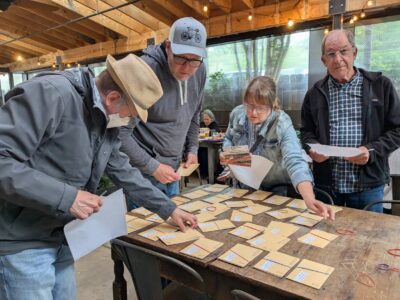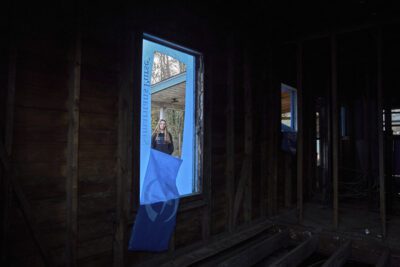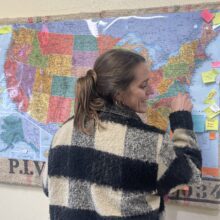
The purple lights are lit above Joshua Wells’ doorway at C.D. Owen Middle School (Owen Middle), which means the resource room is open for business. Inside are bookshelves lined with school supplies — binders, pocket folders, markers, scrap paper, notebooks, and pencils — with book bags stacked on the floor.
Against the window is a makeshift clothing closet. Around a partition are extra toiletries and period products. There is a refrigerator for drinks and racks for food. Wells has a cart he wheels around the hallways for students to grab mid-afternoon snacks. In the middle of the room, there are bean bags for a hangout space.
Wells has been the community school coordinator here for nine years, and the lights above the resource room were his bright idea.
“We’ve really been working on trying to make our school a legit place for the whole community to be,” Wells said.
The room, its supplies, and Wells are all there thanks to the United Way of Asheville and Buncombe County (UWABC) community schools network, which connects Owen Middle with local partners.

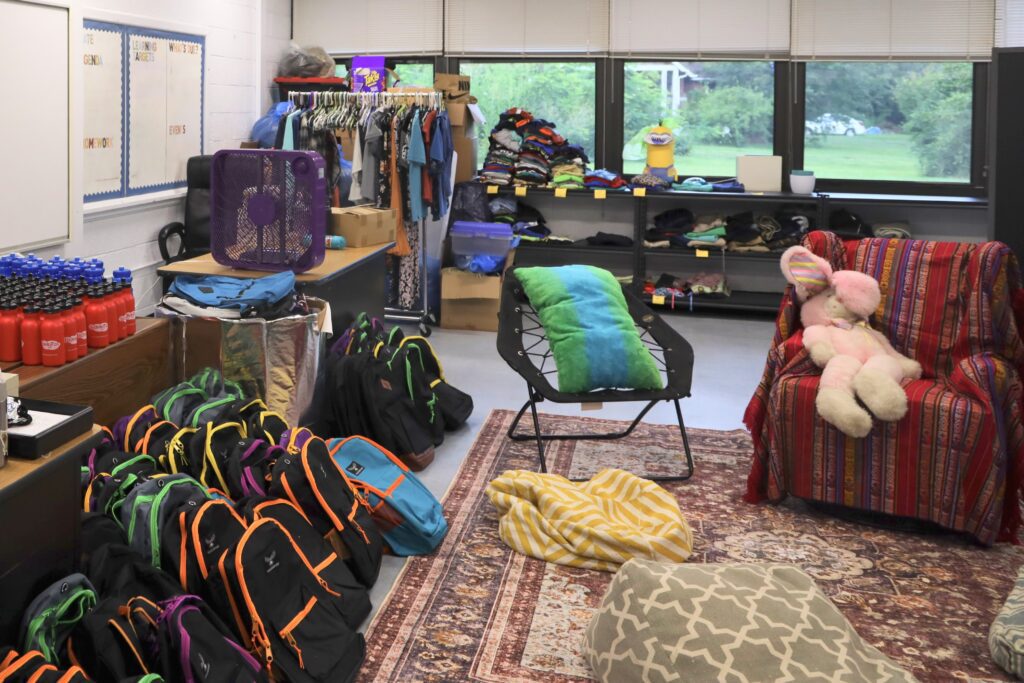
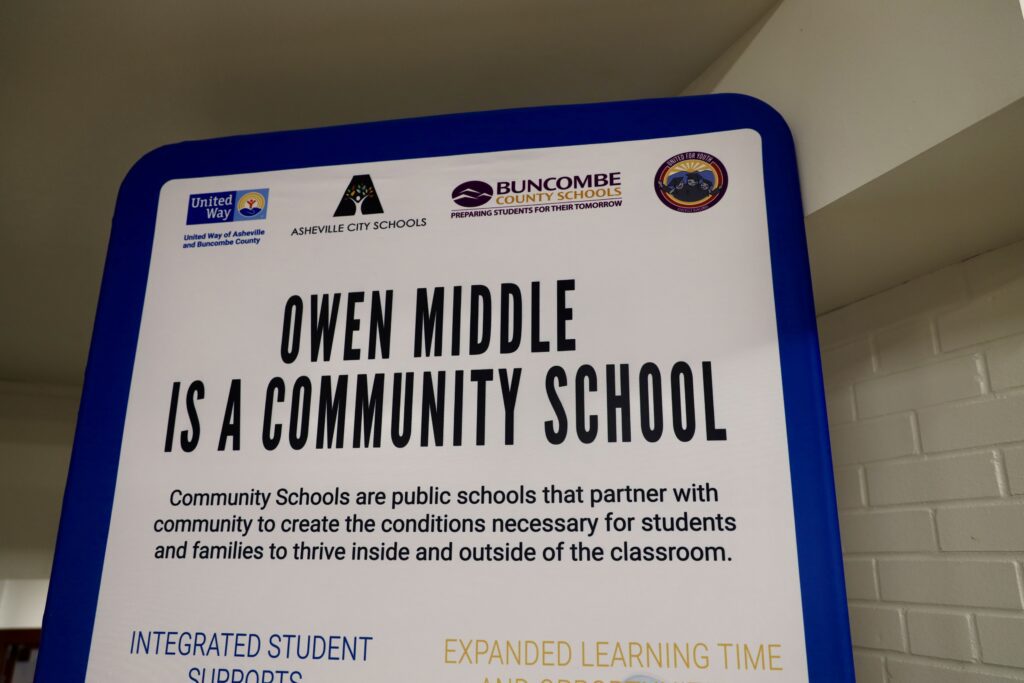

What is a community school?
Owen Middle is a public school that is a community school, which means it coordinates collaboration between a school, students, families, and the greater community to make a plan that addresses the unique vision and needs of an area.
The United Way community schools have four pillars: active family and community engagement, integrated student supports, collaborative leadership and practice, and expanded learning time and opportunities.
“I don’t know how administrators function in a non-community school,” said Owen Middle’s assistant principal, Megan Davis. “Truly, I don’t ever wonder that a kid’s needs aren’t going to be met (here).”
Davis says being a community school takes the stress off of families. According to Davis, that’s because families know that what their children need, the school can help provide. Davis said that removing that — the need to ask for help — alleviates the burden for families who may need help with resources.
“There’s a lot of worries as a school leader, that I think I would have if we were not a United Way School,” said Davis.

Leading during and after Hurricane Helene
Owen Middle is part of Buncombe County Schools (BCS), which has eight other United Way community schools. BCS was out for five weeks due to region-wide damage brought about by Hurricane Helene. The Swannanoa Valley was hard hit. Bradley McMahan, Owen Middle’s principal, said he and his students shared the same lived experience during and after the storm.
“I never had any doubt that our kids and our community would be so resilient,” said McMahan.
Local Helene stories
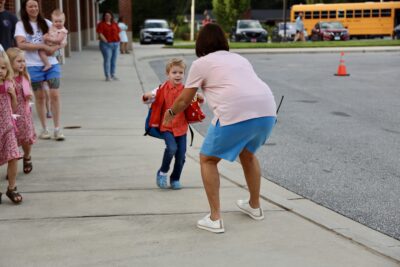
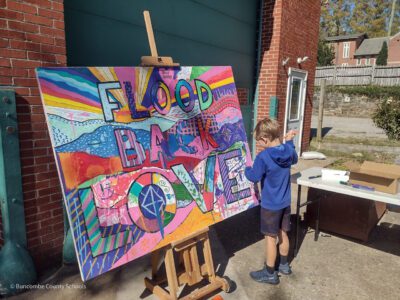
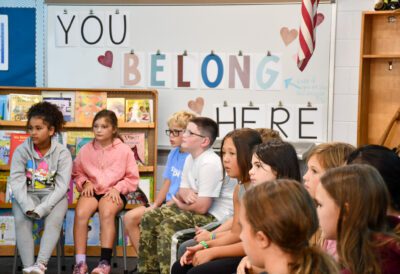
McMahan grew up in the valley, his parents were both educators, and his sister teaches at W. D. Williams Elementary. He went to school in the area, after college taught in BCS, and now leads the middle school he once attended. His father even came out of retirement one year when the opportunity arose for them to teach together at Valley Springs Middle School.
“When you see all the things that happened last year, you know people are like, ‘It’s just unbelievable.’ And I’m like, it’s absolutely believable. We knew we could do it. You just hope you never have to be put to that test.”
Bradley McMahan, Principal at C.D. Owen Middle School
Since Owen Middle was an established community school, the relationship already existed for families to look there for resources, information, and a gathering place after Helene. Wells said he was used to coordinating logistics in his job as community school coordinator, so he put those same skills to use in Helene’s relief and recovery.
As far as leading the school during such a large and unprecedented natural disaster, McMahan credits his community. “I was never dealing with it alone,” he said.
Enrollment at Owen Middle was up in the first week of the 2025-26 school year by over 40 students, compared to last year.
“I tell our students all the time, ‘I look forward to you being my neighbors one day.’ And, ‘Our goal is to make you good neighbors, right?’” said McMahan.
![]() Sign up for the EdWeekly, a Friday roundup of the most important education news of the week.
Sign up for the EdWeekly, a Friday roundup of the most important education news of the week.
A community school at work
While EdNC toured Owen Middle’s resource room on the second day of school, a teacher entered and gathered supplies for students. He requested more pocket folders, so Wells promised to add them to his shopping list.
The immediate access to resources and the funding to go get what may not be available right then, but soon, sets this school apart from others in the area. Owen Middle is working to become an official MANNA foodbank school pantry. Once this happens, Wells can put in orders for the food that his students want. Wells also engages with local food partners, Bounty and Soul, to get fresh fruits and veggies for his students.
During the week, Thursdays are “Community Nights” where any family in the Owen district can come to school for a catered meal and homework help.
Owen Middle is centrally located between the two townships it serves, Swannanoa and Black Mountain. It sits on 40 acres of land, and the school’s leadership wants the community to use it. “I tell families frequently, ‘This is your school,'” said McMahan.
The school receives support from the local Kiwanis, the Black Mountain Rotary Club, and the Boys and Girls Club, among others. Its after-school program was previously managed by the local YMCA, and received additional funding from a Dogwood Health Trust (DHT) grant to expand. There is now a coordinator at Owen Middle that manages the after-school offerings.
This grant, combined with funding from the UWABC, supported additional transportation. Bus drivers were hired for additional hours, allowing them to drop students off at home later if they participate in clubs.
Thanks to the grant, educators received stipends for their extra time spent at school. The number of clubs grew to nearly 30.
Owen Middle is the smallest middle school in the county, with the most students participating in athletics. Combine the after-school programming with this, and sometimes over half the school is on campus until nearly 5 o’clock every day, McMahan said. And that’s how he wants it.
“I don’t ever take it lightly that people just trust us with their kids for eight hours a day, 40 hours a week,” said McMahan. He believes in transparency and partnering with families.
McMahan wants families to have confidence in the educational experience their kids — his students — will get at Owen Middle. Just as he did.
“I want everybody, fundamentally, to believe that they can’t wait for their kids to get to Owen Middle,” McMahan said.
Editor’s note: The Dogwood Health Trust supports the work of EdNC.
Recommended reading
